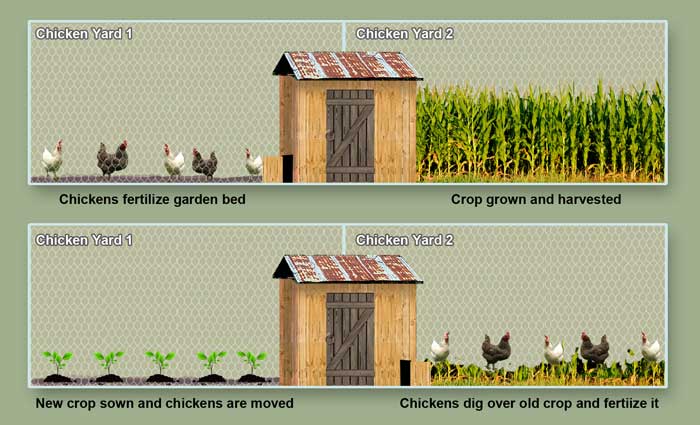Victory Garden Chicken System
The notion of Victory Gardens sounds rather quaint these days and conjures up ideas of thrift and service for the war effort. Used throughout the United Kingdom, the United States, Canada and other places, the Victory Garden was a symbol of pride that helped take pressure off the country’s food production effort during times of crisis like World War One and Two.
One idea that was born in that period and mentioned by Geoff Lawton recently whilst we were filming The Urban Permaculture DVD was just how the domestic chicken coop was pressed into action in a slightly unusual way. Visiting a domestic chicken coop Geoff commented how the floor of the yard was bone dry. The chickens have scratched the ground completely of top soil leaving the tree roots exposed. In general, this is not a good idea as there is no place for the chickens to take a dust bath as chickens love to scratch up sand and dirt and get rid of any stray mites that may be hidden in their feathers. The owner of this property had decided to screen off part of the yard from a neighbours boundary and placed large pot plants with trees in the yard. The pot plants had stayed in the yard for quite some time and the chickens decided the soil in the pot plant would make an excellent place for a dust bath. Whilst discussing the virtues of converting this chicken coop into a deep litter system, Geoff mentioned the possibilities of turning this long chicken run into a Double Run Chicken System. He said such a system was employed in England during the war as a Victory Garden.
The Double Run Chicken System
Geoff suggested that this chicken coop which had a generous run could be more productive if the owner would fence off half the yard – effectively splitting it into two chicken runs. Splitting the chicken coop into two runs or yards meant that the chickens could scratch and fertilize one area whilst the other zone was used to grow a main crop of vegetables. The chickens of course would have no access to this area until the produce was harvested and ready to be processed again. Then the chickens would be switched over to the second zone and allowed to dig through and fertilize this side of the coop. Adding any organic matter, tree branches, mulch and weeds helps the chickens build a rich mulch that will eventually break down and be used to build up the soil and replanted with vegetables. Look at it as a two-stroke food production engine. One area remains fallow, having the chickens fertilize it and matter break down and the other area is actively producing food. By rotating the crops and running the chickens from one spot to another – your chickens remain healthy and active.
The old chicken yard would be dug over and a fresh crop of seedlings planted. Because the chickens have fertilized the area and compacted the soil slightly any dirt that is moist in this spot will have a number of earth worms thriving in the ground below it. The chickens can’t get at the worms, but using a spade or a fork we can easily lift the compacted garden bed and aerate the soil. Those heavy ammonia smelling chicken coops you sometimes smell tell you that the soil is anaerobic caused by bacteria that can thrive without oxygen. Aerating the chicken bed speeds up the decomposition of the soil and allows the chickens to scratch for bugs, enjoy an occasional dust bath and if you decide to move the chickens elsewhere, be a perfect spot for a vegetable garden. In such a system because of the added Carbon, you are actively building soil into your garden and working on a solid foundation of sustainability. Its also a great way to maximize your garden space.








Recent Comments